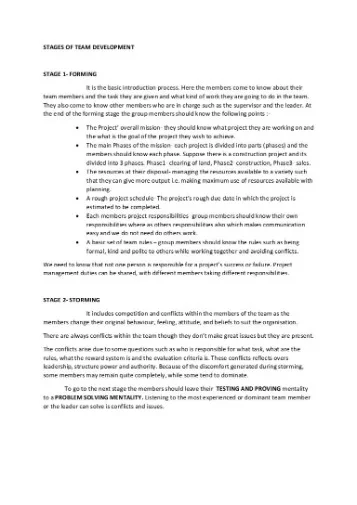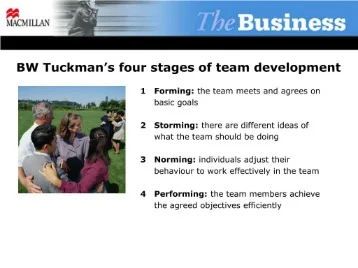Stages of Team Development : Introduction to Speech Communication
Each stage of team development doesn’t necessarily take just as much time as the one that comes after it, nor the one before it. In the performing stage, you’ll notice fluidity with communication and overall conversations. This is demonstrated through high morale, productivity and engagement. It’s an ideal state for any manager to witness their team’s growth and ask reflective questions.The selection of a team leader is of key decision that can have a great impact on the overall success of a team. A good team leader should be able to build and maintain team morale, instilling confidence and trusting in other team members allowing them to work together to achieve the teams goals . The ability to understand the stages of a team and provide the guidance to all members is essential.In 1965, Bruce Tuckman researched group development and identified four distinct stages that all teams must move through in order to become successful. Over the years, I have worked with many teams and have found theses stages to be very predictable. High-performing teams go through four defined stages to reach four stages of team development their potential. This is true whether your team works remotely or works in person. The forming storming norming performing model of group development was first proposed by psychological researcher Bruce Tuckman in 1965. The first step in a team’s life is bringing together a group of individuals.By starting with a free trial, you have the freedom to learn as much as possible about the product before committing to it. If you’ve asked team members to update progress documents weekly, check to make sure it’s being done. Set reminders for yourself to check in with team members, or send calendar events so that making updates is always top of mind and getting done. The main goal here is to keep the momentum going so that the project wraps up on time. Disagreements are unavoidable on teams, especially when each person on the team has a different perspective on how to approach the issues the team encounters. When you all work in the same location, it can be easier to hash out problems quickly.
To grow from this stage to the next, each member must relinquish the comfort of non-threatening topics and risk the possibility of conflict. While working on a high-performing team may be a truly pleasurable and growthful experience, it is not the end of team development. There is still a need for the team to focus on both process and product, setting new goals as appropriate. Changes, such as members coming or going or large-scale changes in the external environment, can lead a team to cycle back to an earlier stage. If these changes – and their resulting behaviors – are recognized and addressed directly, teams may successfully remain in the Performing stage indefinitely. The second stage of group development is known as the storming stage.Forming is a period of testing and orientation in which members learn about each other and evaluate the benefits and costs of continued membership. People tend to be polite, will defer to authority, and try to find out what is expected of them and how they will fit into the team (McShane et al., 2018, p. 232). Do you know where your team falls in the natural progression of team development?The performing stage is a clear indication that your team is in a state of alignment. They not only understand how to ask for help, but they’ve also developed a gauge for when it’s an opportune moment to speak up, and involve you. The norming stage is more harmonious since teams understand why it’s important to ask for help, and how to come to you with questions when they need guidance. This is a concept that psychologist Bruce Tuckman came up with to properly understand the progress of various teams and the development of key contributors. Alignment Get your people in the same mindset with OKR goals and 1-on-1 meetings. During the Ending Stage, some team members may become less focussed on the team’s tasks and their productivity may drop.
Signs and questions to look out for in the storming stage
The forming stage of group development allows group members to form impressions of one another, while conflict and personal opinions are often avoided this early in the group development process. Comparatively, the orientation stage of group development is similar to a first day on the job or the first day of school. Bruce Tuckman suggests that there are four stages of team development; Forming, Storming, Norming and Performing. At the forming stage, the team needs to mature and allow relationships to establish. Everyone’s position is currently unclear so the leader must be ready to answer questions and give a lot of guidance.Because of this the Storming phase is often the most stressful stage for team members. It’s not uncommon for team members to feel overwhelmed during this stage. Double down on building personal connections among teammates. When it’s time to celebrate meeting a milestone, consider indulging in a team dinner or day out doing something fun together. And, now that you’ve figured out established practices that help you collaborate effectively, share those with other teams.
How to make performing run smoothly
These stages are Forming, Storming, Norming and Performing. Tuckman’s final stage of group development, adjourning, was not originally part of his development model. During this closure or mourning phase, the group dissolves or disbands following the successful completion of their main objective. Adjourning is used to wrap up the activities of the group and provide team members with a sense of closure or fulfillment. The closure phase also allows time for reflection between individuals or the group as a whole, enabling them to recognize the valuable experiences which transpired or the skills which have been built upon.
Team members are also self-reliant, meaning they are able to experiment, solve problems, and test solutions on their own. The main objective of the performing stage is to complete the group’s original goal or fulfill its purpose. This is the most dangerous phase in terms of team success.
Learning Outcomes
Timothy Biggs suggested that an additional stage be added of “norming” after “forming” and renaming the traditional norming stage “re-norming”. When your team has grown through the stages of team development they establish a state of “flow”. This means they understand how to work together in a cohesive way that helps them reach their goals. In the Performing stage, the team makes significant progress towards its goals. Commitment to the team’s mission is high and the competence of team members is also high. Team members should continue to deepen their knowledge and skills, including working to continuously improving team development.
- As a new project phase starts new teams are formed and the members will go through the stages.
- This view makes it easy to spot any bottlenecks and the drag-and-drop functionality means you can swiftly move tasks around to adjust your team’s workload.
- Understanding that each stage is normal and expected can relieve a lot of tension and free the team up to break through and move on.
- Services Services Leverage services that provide quick innovation with designs that work the first time—and stay reliable for years.
You come to realize that, by involving yourself, they’re burdened by an apprehension to speak up and would rather spend time rectifying the situation. If you reflect on them, they’ll tell you a cohesive story about their strengths, needs and performance. Guides & tools Downloadable guides for busy managers to drive performance.
Forming Stage
Unfortunately, many staff meetings are not living up to their full potential. I often ask the team to first share their perspective on the purpose of their staff meeting. We then use a “Whole Brain® Thinking” approach to redesign the staff meeting to fulfill that purpose and to ensure all team members’ expectations are being met. End-to-end Demo – A visual representation of the final product or experience makes it easy for stakeholders to provide early feedback. As you repeat this exercise over time, it’ll become higher fidelity and help your team see they’re making progress. Focus on building a shared understanding across your team and with stakeholders.
People get so lost in a specific task that they forget why they are doing it in the first place. Teams need a clear purpose and mission and should be reminded of them often. You don’t have to gain superpowers from a serum or create one of the most iconic brands of your generation to be a great leader. The fourth stage is the one that all groups strive to reach.
Your Team Development Partner
The leader’s role in team building during this stage is a significant one. It’s important to note that not all groups make it past this stage. The leader must stay positive and coach members in assertiveness and, where necessary, conflict resolution skills.
Business Technology Services
When teams work in the same space, it’s easy to see what everyone’s doing. Designers are talking to product managers to get direction, or product managers meet with analysts to talk about user data and reports. It’s different for remote marketing teams because you can’t see what people are working on. To remedy this problem, put processes in place that make it easy for designers, for example, to see how content is developing so that they can anticipate when they’ll be able to complete their updates.
Interdisciplinary Team Approach To Patient Care
This is because your team recognizes how they can trust you and each other in order to complete tasks, move towards their objectives and rely on each other for help. This way, you can prepare for conversations that build trust while supporting your team and leading through each team development stage. Team members are able to prevent or solve problems in the team’s process or in the team’s progress. A “can do” attitude is visible as are offers to assist one another.Alasdair A. K. White together with his colleague, John Fairhurst, examined Tuckman’s development sequence when developing the White-Fairhurst TPR model. They simplify the sequence and group the forming-storming-norming stages together as the “transforming” phase, which they equate with the initial performance level. This is then followed by a “performing” phase that leads to a new performance level which they call the “reforming” phase. “With group norms and roles established, group members focus on achieving common goals, often reaching an unexpectedly high level of success.” By this time, they are motivated and knowledgeable. The team members are now competent, autonomous and able to handle the decision-making process without supervision.


